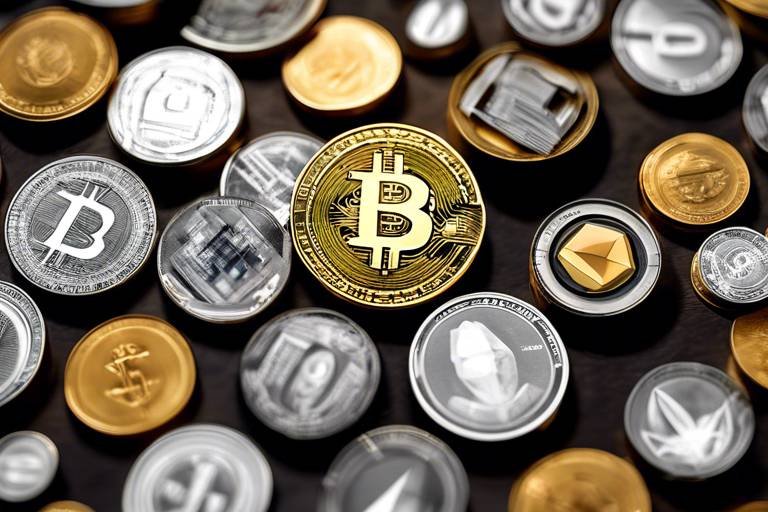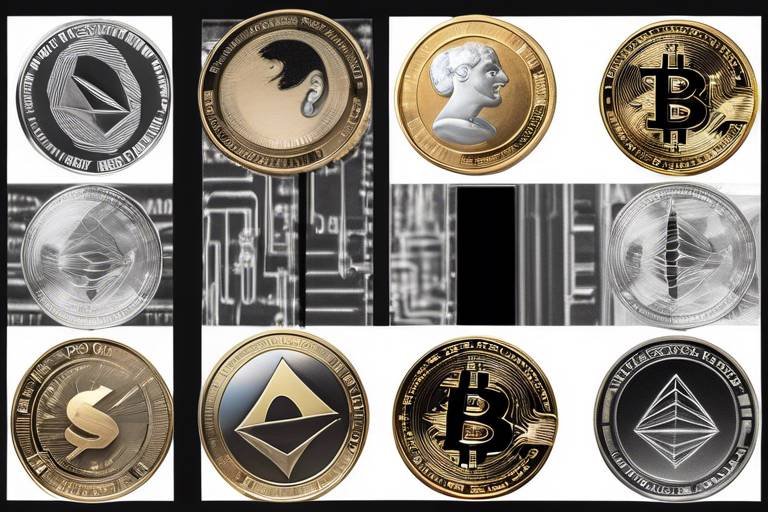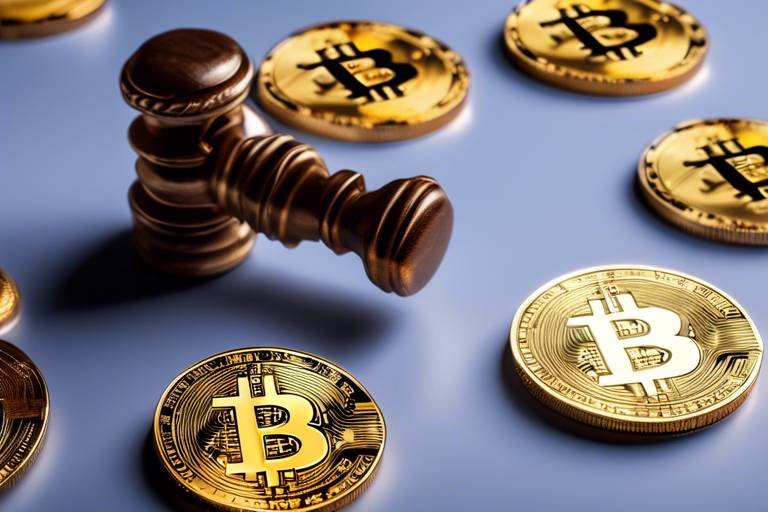How Decentralized Finance is Changing Lending
In recent years, the financial landscape has undergone a seismic shift, primarily driven by the rise of Decentralized Finance (DeFi). This innovative approach is not just a trend; it's a revolution that is fundamentally altering how we think about lending. Imagine a world where you can lend and borrow money without the need for banks or intermediaries. Sounds intriguing, right? Well, that's exactly what DeFi offers! By leveraging blockchain technology, DeFi lending platforms provide users with unparalleled accessibility and flexibility. No longer do we have to navigate the often cumbersome processes of traditional banks; instead, we can engage in financial transactions with just a few clicks.
The beauty of DeFi lending lies in its ability to democratize access to financial services. Whether you're a seasoned investor or someone looking to secure a small loan, DeFi platforms open the door to a world of possibilities. This shift is not just about convenience; it's about empowerment. Users can now manage their loans and investments directly, eliminating the need for intermediaries who often charge hefty fees. It's like having a personal bank in your pocket, available 24/7, ready to cater to your financial needs.
However, this transformation doesn't come without its challenges. The decentralized nature of these platforms raises questions about security, regulatory compliance, and market volatility. Users must navigate a landscape filled with potential risks, but the rewards can be substantial. Imagine being able to earn interest on your assets while maintaining complete control over your funds. That's the allure of DeFi lending, and it's drawing more and more people into this exciting new financial frontier.
As we delve deeper into how DeFi is reshaping lending practices, we'll explore the underlying technologies, the benefits and limitations of smart contracts, and the impact this has on traditional lending institutions. Buckle up, because the future of finance is here, and it's decentralized!
DeFi lending platforms have emerged as a revolutionary alternative to traditional banking, offering users greater accessibility and flexibility in managing loans and investments without intermediaries. These platforms utilize blockchain technology to facilitate peer-to-peer lending, which means that individuals can lend money to one another directly, bypassing the traditional banking system. This not only reduces costs but also enhances the speed of transactions. Imagine being able to secure a loan within minutes, rather than days or weeks as is typical with banks. This is the power of DeFi lending.
One of the most significant advantages of DeFi lending platforms is their global reach. Anyone with an internet connection can access these services, making them particularly valuable in regions where traditional banking is underdeveloped. Moreover, users can often obtain loans without extensive credit checks, which can be a barrier in conventional finance. This opens up opportunities for individuals who might otherwise be excluded from the financial system.
At the heart of DeFi lending are smart contracts, which are self-executing contracts with the terms of the agreement directly written into code. These contracts facilitate automated, trustless transactions in DeFi lending, ensuring secure and efficient loan agreements without the need for traditional financial institutions. Think of smart contracts as the digital equivalent of a vending machine: you put in your money, select your product, and the machine automatically delivers it to you without any human intervention.
Smart contracts provide numerous advantages, including:
- Reduced Transaction Costs: By eliminating intermediaries, users save on fees.
- Faster Processing Times: Transactions occur almost instantaneously.
- Enhanced Security: The use of cryptographic protocols ensures that agreements are tamper-proof.
All of these factors contribute to a more efficient lending ecosystem, where users can focus on their financial goals without the hassle of traditional banking processes.
The security of smart contracts is paramount, as they utilize cryptographic protocols to protect against fraud and unauthorized access, ensuring that funds remain secure throughout the lending process. This security is a game-changer, as it builds trust among users who may be hesitant to engage with new technologies.
Despite their benefits, smart contracts also have limitations, such as potential coding errors and the necessity for users to understand blockchain technology, which can hinder widespread adoption. It's crucial for users to educate themselves about the technology to fully leverage its potential, as ignorance can lead to costly mistakes.
While DeFi lending presents exciting opportunities, it also comes with inherent risks, including market volatility, regulatory uncertainties, and potential security vulnerabilities that users must navigate. The landscape is still evolving, and with that comes a level of unpredictability that can be daunting for new users.
The rise of DeFi lending is forcing traditional financial institutions to adapt and innovate, as they face competition from decentralized platforms that offer better rates and services. Traditional banks are now exploring partnerships and integrating blockchain technology to remain relevant in this evolving financial landscape shaped by DeFi lending solutions. It's a wake-up call for the banking sector, compelling them to rethink their strategies and embrace technological advancements.
As the DeFi movement gains momentum, banks are recognizing the need to innovate. Many are actively seeking to incorporate blockchain technology into their operations, whether through partnerships with DeFi platforms or by developing their own decentralized solutions. This shift not only helps them stay competitive but also enhances their service offerings, ultimately benefiting consumers.
Regulators are increasingly scrutinizing DeFi lending, prompting discussions about compliance, consumer protection, and the need for frameworks that balance innovation with safety in the financial sector. As the landscape evolves, it's essential for regulators to find a middle ground that encourages innovation while safeguarding consumers from potential risks.
What is DeFi lending? DeFi lending refers to decentralized finance platforms that allow users to lend and borrow without traditional banks, using blockchain technology.
How do smart contracts work in DeFi lending? Smart contracts automate loan agreements and transactions, ensuring they are executed securely and without intermediaries.
What are the risks associated with DeFi lending? Risks include market volatility, regulatory uncertainties, and potential security vulnerabilities.
Can anyone access DeFi lending platforms? Yes, anyone with an internet connection can access DeFi lending platforms, making them highly accessible.

The Rise of DeFi Lending Platforms
The emergence of Decentralized Finance (DeFi) has opened a new chapter in the world of lending, creating a paradigm shift that challenges the traditional banking system. DeFi lending platforms are revolutionizing how individuals access loans and manage their investments. Imagine a world where you can lend or borrow money without the need for a bank, where transactions occur directly between peers through the magic of blockchain technology. This is not just a dream; it’s happening right now!
One of the most significant advantages of DeFi lending platforms is their ability to provide greater accessibility and flexibility. With just a smartphone and an internet connection, anyone can participate in the lending ecosystem. This democratization of finance allows individuals from all walks of life to engage in lending and borrowing activities, breaking down barriers that have historically excluded many from traditional financial services. For instance, someone in a developing country can now access loans that were once only available to those with a solid credit history in developed nations.
Moreover, DeFi lending platforms operate without intermediaries, which means lower fees and faster processing times. Traditional banks often have lengthy approval processes and charge high fees for their services. In contrast, DeFi platforms utilize smart contracts to automate the lending process, ensuring that transactions are executed quickly and efficiently. This not only saves time but also reduces the overall cost of borrowing, making it more appealing for users.
However, while the benefits are substantial, the rise of DeFi lending platforms also brings forth certain challenges. Users must navigate a landscape filled with new terminologies, technologies, and potential risks. It’s essential for individuals to familiarize themselves with the workings of blockchain and smart contracts to fully leverage the advantages of DeFi lending. As more people become aware of these platforms and their functionalities, we can expect a significant shift in how financial transactions are conducted.
To illustrate the impact of DeFi lending, consider the following table that compares traditional lending with DeFi lending:
| Aspect | Traditional Lending | DeFi Lending |
|---|---|---|
| Intermediaries | Yes (Banks, Credit Unions) | No (Peer-to-Peer) |
| Accessibility | Restricted (Credit Score Required) | Open (Anyone with Internet) |
| Processing Time | Days to Weeks | Minutes to Hours |
| Fees | High (Service Charges) | Low (Network Fees) |
| Security | Moderate (Regulated) | High (Cryptographic Protocols) |
As we continue to witness the rise of DeFi lending platforms, it’s clear that they are not just a passing trend but a fundamental shift in how we think about finance. With their innovative solutions, they are paving the way for a more inclusive and efficient financial system. As more users embrace these platforms, we can expect to see a transformation in lending practices that prioritizes transparency and empowerment.
- What is DeFi lending? - DeFi lending refers to the process of lending and borrowing cryptocurrencies or digital assets through decentralized platforms without intermediaries.
- How do I get started with DeFi lending? - To start, you need a cryptocurrency wallet and some digital assets. You can then choose a DeFi platform to lend or borrow.
- Is DeFi lending safe? - While DeFi lending has security features, it is essential to understand the risks involved, including market volatility and potential bugs in smart contracts.
- Can anyone use DeFi lending platforms? - Yes, anyone with an internet connection and a cryptocurrency wallet can access DeFi lending platforms.

Smart Contracts: The Backbone of DeFi Lending
When we think about the future of finance, smart contracts stand out as one of the most innovative components driving the DeFi lending revolution. Imagine a world where loans are processed without the need for a bank or a middleman. Sounds like science fiction, right? But thanks to blockchain technology, this is becoming a reality! Smart contracts are self-executing contracts with the terms of the agreement directly written into code. They operate on a decentralized network, ensuring that both parties fulfill their obligations without needing to trust each other or rely on a third party.
These contracts are not just a fancy tech term; they are the backbone of DeFi lending. They automate the entire lending process, from initiating a loan to its repayment. Picture this: you want to borrow some cryptocurrency. Instead of filling out endless paperwork and waiting for bank approval, you can simply interact with a DeFi platform. The smart contract checks your collateral, executes the loan, and even enforces repayment—all in a matter of seconds. It’s like having a personal assistant that never sleeps!
One of the most significant advantages of smart contracts is their ability to create a trustless environment for transactions. In traditional lending, trust is established through banks and intermediaries. However, in the DeFi world, trust is built into the code. This means that once a smart contract is deployed, it cannot be altered or tampered with, ensuring that all parties adhere to the agreed terms. This not only enhances transparency but also significantly reduces the risk of fraud.
Smart contracts offer a plethora of benefits that make them an attractive option for both lenders and borrowers. Here are some key advantages:
- Reduced Transaction Costs: By eliminating intermediaries, smart contracts can drastically lower the fees associated with lending.
- Faster Processing Times: Traditional loans can take days or even weeks to process. Smart contracts, on the other hand, can execute transactions in mere minutes.
- Enhanced Security: With cryptographic protocols in place, smart contracts provide a secure environment for financial transactions.
Security is a critical aspect of any financial transaction, and smart contracts take this seriously. They employ advanced cryptographic protocols to safeguard against unauthorized access and fraud. This means that your funds are protected throughout the lending process, providing peace of mind to both lenders and borrowers. However, it’s essential to understand that the security of a smart contract also depends on the quality of the code. A poorly written contract can expose users to vulnerabilities, which is why it’s crucial to work with reputable DeFi platforms that prioritize security.
Despite their numerous benefits, smart contracts are not without their limitations. For instance, coding errors can lead to significant issues, including the loss of funds. Moreover, users must have a basic understanding of blockchain technology to navigate these platforms effectively. This can be a barrier to entry for many potential users who may find the technology daunting. Therefore, while smart contracts are paving the way for a new era of lending, education and accessibility remain critical challenges that need addressing.
In conclusion, smart contracts are a game-changer for the DeFi lending landscape. They provide a secure, efficient, and automated way to manage loans, making financial transactions more accessible to everyone. As the DeFi space continues to evolve, we can expect smart contracts to play an even more significant role in shaping the future of finance.
What are smart contracts?
Smart contracts are self-executing contracts with the terms of the agreement directly written into code on a blockchain. They automate transactions and ensure that all parties fulfill their obligations.
How do smart contracts enhance security in lending?
Smart contracts use cryptographic protocols to protect against fraud and unauthorized access, ensuring that funds remain secure throughout the lending process.
What are the risks associated with smart contracts?
While they offer many benefits, risks include potential coding errors and the need for users to understand blockchain technology, which can hinder widespread adoption.

Benefits of Using Smart Contracts
Smart contracts are revolutionizing the lending landscape in decentralized finance (DeFi) by offering a plethora of benefits that traditional lending systems simply can't match. Imagine a world where loans are processed in a matter of minutes, without the need for endless paperwork and tedious approval processes. That's the promise of smart contracts! These self-executing contracts run on blockchain technology, which means they automatically enforce the terms of an agreement once predefined conditions are met. This automation not only streamlines operations but also enhances trust between parties.
One of the most significant advantages of using smart contracts in DeFi lending is the reduction in transaction costs. Traditional banks often charge hefty fees for processing loans, but with smart contracts, these costs are significantly lowered. This is because the role of intermediaries—like banks and brokers—is eliminated, allowing users to interact directly with one another. As a result, borrowers can enjoy lower interest rates, while lenders can earn higher returns on their investments.
Furthermore, the speed at which transactions occur is another game-changer. In traditional finance, securing a loan can take days or even weeks, but with smart contracts, the process is almost instantaneous. Once the conditions are met—say, a borrower depositing collateral—the loan is automatically executed. This efficiency not only saves time but also enhances user satisfaction. Who wouldn't want to skip the long lines and bureaucratic red tape?
Security is yet another critical aspect where smart contracts shine. They use cryptographic protocols to ensure that transactions are secure and tamper-proof. This means that once a contract is deployed on the blockchain, it cannot be altered or hacked without the consensus of the network. This level of security is paramount, especially in a world where financial fraud is rampant. Users can rest easy knowing their funds are protected throughout the lending process.
However, it’s essential to recognize that while smart contracts offer these remarkable benefits, they are not without their challenges. For instance, users must have a basic understanding of blockchain technology to engage with these contracts effectively. This learning curve can be a barrier for some, but as education around DeFi grows, we can expect more people to embrace this innovative approach to lending.
In summary, the benefits of using smart contracts in DeFi lending are transformative. They offer reduced costs, faster processing times, and enhanced security, creating a more efficient lending ecosystem. As we continue to navigate this exciting landscape, it’s clear that smart contracts will play a pivotal role in shaping the future of finance.
- What are smart contracts? Smart contracts are self-executing contracts with the terms of the agreement directly written into code, running on a blockchain.
- How do smart contracts reduce costs? They eliminate the need for intermediaries, which lowers transaction fees and allows for better rates for both borrowers and lenders.
- Are smart contracts secure? Yes, they utilize cryptographic protocols to ensure that transactions are secure, tamper-proof, and transparent.
- What challenges come with using smart contracts? Users need to understand blockchain technology, and there can be potential coding errors that may lead to vulnerabilities.

Security Features of Smart Contracts
When it comes to decentralized finance (DeFi), security is not just an afterthought; it’s the very foundation upon which trust is built. Smart contracts are designed to be self-executing agreements with the terms of the contract directly written into code. This means that once a smart contract is deployed on the blockchain, it operates automatically, without the need for human intervention. But what makes these contracts so secure?
First and foremost, smart contracts utilize cryptographic protocols to ensure that all transactions are secure and tamper-proof. Each transaction is encrypted, making it nearly impossible for anyone to alter the data without detection. This level of security is akin to having a vault that not only locks up valuable assets but also alerts you the moment someone tries to breach it. Furthermore, since these contracts are executed on a blockchain, they benefit from the decentralized nature of the technology. This means that there’s no single point of failure; even if one part of the network is compromised, the rest remains intact.
Another important feature is the concept of transparency. All transactions made through smart contracts are recorded on the blockchain, which is publicly accessible. This transparency fosters a sense of accountability, as anyone can verify the terms and conditions of a contract, ensuring that all parties adhere to their obligations. Imagine being able to see exactly how a loan was structured and the terms agreed upon without needing to trust a bank or financial institution. This level of visibility is revolutionary.
Moreover, smart contracts can incorporate multi-signature wallets as a security measure. This means that multiple parties must approve a transaction before it can be executed. It’s like having a team of guardians who all need to give the green light before any funds are moved. This significantly reduces the risk of fraud, as it requires collusion among multiple parties to compromise the contract.
However, while these security features are robust, it’s essential to acknowledge that they are not foolproof. The security of a smart contract is only as good as the code it is built upon. If there are coding errors or vulnerabilities, they can be exploited by malicious actors. Therefore, regular audits and testing are crucial to ensure that smart contracts remain secure over time. In essence, while smart contracts do offer enhanced security features, they also require vigilance and ongoing maintenance to safeguard against potential threats.
In conclusion, the security features of smart contracts represent a significant leap forward in the lending landscape. By leveraging cryptography, transparency, and multi-signature capabilities, they provide a level of security that traditional lending methods simply cannot match. As we continue to embrace the potential of DeFi, understanding these features will be crucial for users looking to navigate this new financial frontier safely.
- What are smart contracts? Smart contracts are self-executing contracts with the terms of the agreement directly written into code, allowing for automated transactions without intermediaries.
- How do smart contracts ensure security? They use cryptographic protocols, operate on a decentralized blockchain, and can incorporate multi-signature wallets to enhance security.
- Are smart contracts completely secure? While they offer robust security features, they are not infallible. Coding errors and vulnerabilities can pose risks, making regular audits essential.
- What role does transparency play in smart contracts? Transparency allows all parties to verify the terms and conditions of a contract, fostering accountability and trust.

Limitations of Smart Contracts
While smart contracts are indeed a game-changer in the world of decentralized finance (DeFi), they are not without their limitations. One of the most significant challenges is the potential for coding errors. Imagine writing a computer program that controls your entire financial transaction—if there's a bug, it could lead to unintended consequences. This risk is heightened in the DeFi space, where the stakes are often much higher than in traditional applications. A simple mistake in the code could result in lost funds or failed transactions, which can be devastating for users.
Moreover, the complexity of blockchain technology can be overwhelming for the average person. Users need a certain level of understanding to navigate these platforms successfully. This can create a barrier to entry, preventing many potential users from taking advantage of the benefits that DeFi has to offer. It’s like trying to drive a car without knowing how to operate the gears; if you don’t understand what you’re doing, you might end up in a ditch.
Another limitation is the lack of legal recourse. In traditional lending, if something goes wrong, you have avenues to seek help, whether through customer service or legal action. However, in the world of smart contracts, once the agreement is executed, it’s often irreversible. If you find yourself in a dispute, the decentralized nature of these platforms means there’s no one to turn to for help. This can be particularly concerning for users who are new to the space and may not fully understand the implications of their actions.
Furthermore, smart contracts are also limited by the underlying blockchain technology. Different blockchains have varying levels of scalability, speed, and transaction costs. For instance, during times of high demand, some networks experience congestion, leading to increased fees and slower transaction times. This can be frustrating for users who expect quick and efficient service. The following table illustrates some of the key differences in transaction speeds and costs across popular blockchains used for DeFi:
| Blockchain | Transaction Speed (seconds) | Average Transaction Cost (USD) |
|---|---|---|
| Ethereum | 15 | ~$5 |
| Binance Smart Chain | 3 | ~$0.10 |
| Solana | 0.4 | ~$0.01 |
In conclusion, while smart contracts offer a plethora of benefits, including automation and security, their limitations cannot be overlooked. Users must navigate the complexities of coding, legal implications, and the performance of underlying technologies. Understanding these limitations is crucial for anyone looking to engage with DeFi lending platforms effectively.
- What are smart contracts? Smart contracts are self-executing contracts with the terms of the agreement directly written into code, facilitating and enforcing the negotiation or performance of a contract.
- How do smart contracts ensure security? They utilize cryptographic protocols to protect against fraud and unauthorized access, ensuring that funds remain secure throughout the lending process.
- What happens if there’s a bug in a smart contract? A bug can lead to unintended consequences, such as lost funds or failed transactions, highlighting the importance of thorough testing and audits.
- Can I get my money back if something goes wrong? Generally, there is no legal recourse in the DeFi space, meaning that once a transaction is executed, it is often irreversible.

Risks and Challenges in DeFi Lending
As we dive into the exciting world of decentralized finance (DeFi) lending, it’s essential to recognize that with great innovation comes great responsibility—or, in this case, risk. While DeFi lending platforms promise to democratize access to financial services, they also expose users to a myriad of challenges that can impact their investments and financial security. One of the most significant risks is market volatility. The cryptocurrency market is notorious for its price swings, and when you’re dealing with assets that can fluctuate wildly, it’s easy to see how a seemingly stable loan can quickly turn into a burden. Imagine taking out a loan in a cryptocurrency that plummets in value overnight; that’s a risk many DeFi users face daily.
Another challenge lies in the regulatory landscape. As DeFi continues to grow, it attracts the attention of regulators who are keen to understand and control this new financial frontier. The lack of clear regulations can lead to uncertainty, making it difficult for users to navigate the legal implications of their transactions. This is particularly concerning for investors who may not be fully aware of their rights or the protections available to them. Moreover, as regulations evolve, they could potentially stifle innovation, which is a double-edged sword for the DeFi community.
Security vulnerabilities also pose a significant threat in the DeFi lending space. While smart contracts are designed to be secure, they are not immune to bugs or exploits. A single coding error can lead to catastrophic losses, as seen in several high-profile hacks where millions of dollars were stolen due to vulnerabilities in the underlying code. This underscores the importance of thorough audits and the need for users to conduct their due diligence before engaging with any DeFi platform. It’s a bit like buying a used car; you wouldn’t just take the seller’s word for it—you’d want to check the vehicle’s history and condition.
Furthermore, the complexity of DeFi platforms can be daunting for the average user. Many protocols require a certain level of technical knowledge, which can alienate potential borrowers and lenders who are not tech-savvy. This steep learning curve can hinder widespread adoption, as individuals may shy away from using platforms that seem too complicated or risky. As a result, the DeFi community must work towards creating more user-friendly interfaces and educational resources to bridge this gap.
In summary, while DeFi lending offers exciting opportunities for financial empowerment, it is crucial for users to remain vigilant about the inherent risks involved. By understanding market volatility, staying informed about regulatory changes, prioritizing security, and seeking out user-friendly platforms, individuals can navigate the DeFi landscape more effectively. Remember, in the world of finance, knowledge is power, and being informed is your best defense against potential pitfalls.
- What is DeFi lending? DeFi lending refers to decentralized platforms that allow users to lend or borrow cryptocurrencies without traditional intermediaries like banks.
- What are the main risks associated with DeFi lending? The main risks include market volatility, regulatory uncertainties, security vulnerabilities, and the complexity of the technology.
- How can I protect myself when using DeFi lending platforms? Conduct thorough research, ensure the platform has undergone security audits, and only invest what you can afford to lose.
- Are DeFi lending platforms regulated? Currently, DeFi lending operates in a largely unregulated space, but this is changing as regulators begin to take notice.

Impact on Traditional Lending Institutions
The emergence of decentralized finance (DeFi) lending platforms is shaking up the financial landscape in ways that many traditional lending institutions never saw coming. Imagine a world where you can secure a loan without stepping into a bank or dealing with lengthy paperwork. That's the reality that DeFi is creating, and it's forcing traditional banks to rethink their strategies. As consumers become more aware of their options, the competitive pressure on these institutions is intensifying. They are no longer just competing with each other; they are now up against a new breed of financial services that offer lower fees, faster transactions, and greater accessibility.
One of the most significant impacts of DeFi on traditional lending is the shift in consumer expectations. Today’s borrowers are looking for convenience and speed. They want to access their funds quickly, without the cumbersome processes that have long defined banking. For instance, in a traditional setup, getting a personal loan could take days or even weeks, while DeFi platforms can process loans in a matter of minutes. This rapid turnaround time is not just a perk; it's becoming a standard that traditional banks must strive to meet.
To remain relevant, many banks are exploring partnerships with DeFi platforms or even developing their own blockchain-based solutions. They recognize that to keep their customer base, they need to innovate. This could mean integrating smart contracts into their lending processes or offering hybrid services that combine the best of both worlds. However, the challenge lies in balancing innovation with the regulatory frameworks that govern traditional finance.
Moreover, as DeFi continues to grow, it raises questions about the future roles of banks. Will they become mere custodians of funds, or will they evolve into tech-driven financial advisors? The answer might depend on how quickly they adapt to these changes. Many banks are already investing in technology and talent to better understand blockchain and DeFi, but will that be enough?
In response to this shifting landscape, regulators are also stepping in to ensure that consumer protections are in place. As DeFi lending grows, so does the need for clear guidelines that protect consumers while fostering innovation. Traditional banks, with their established compliance frameworks, may have a leg up in navigating these waters, but they must remain vigilant. The risk of falling behind is very real, and as the saying goes, “adapt or die.”
In summary, the impact of DeFi on traditional lending institutions is profound. It is not just a challenge; it is an opportunity for growth and transformation. Banks that embrace these changes and leverage technology to enhance their services will likely emerge stronger, while those that cling to outdated practices may find themselves outpaced in a rapidly evolving market.
- What is decentralized finance (DeFi)? DeFi refers to financial services that use blockchain technology to operate without intermediaries, allowing users to lend, borrow, and trade directly.
- How does DeFi lending differ from traditional lending? DeFi lending offers quicker transactions, lower fees, and greater accessibility, while traditional lending typically involves banks and lengthy processes.
- Are DeFi platforms safe to use? While DeFi platforms can offer enhanced security through smart contracts, they are not without risks, including market volatility and potential coding errors.
- What should traditional banks do to compete with DeFi? Traditional banks should explore partnerships with DeFi platforms and invest in technology to innovate their services and meet changing consumer expectations.

Adapting to the DeFi Landscape
The rise of decentralized finance (DeFi) is not just a fleeting trend; it's a tectonic shift in how we perceive and interact with financial services. Traditional banks and lending institutions are now at a crossroads, faced with the undeniable reality that they must adapt or risk obsolescence. Imagine a world where financial transactions are as easy as sending an email—this is the promise that DeFi brings, and it’s forcing legacy financial systems to rethink their strategies.
To stay competitive, many banks are exploring partnerships with DeFi platforms. This is akin to a traditional store collaborating with an online marketplace to reach a broader audience. By embracing blockchain technology, banks can offer their customers the best of both worlds: the reliability of a traditional institution combined with the innovative features of DeFi. For instance, by integrating smart contracts, banks can streamline their loan processes, reduce costs, and enhance user experience. This not only fosters customer loyalty but also attracts a younger demographic that values speed and efficiency.
Moreover, banks are beginning to recognize the importance of transparency and security that DeFi platforms inherently provide. In a world where data breaches and fraud are rampant, the decentralized nature of DeFi can serve as a robust alternative. Customers are increasingly looking for services that offer clear terms and conditions, and DeFi platforms excel in this regard by allowing users to see exactly how their funds are being utilized. This shift towards transparency is not just beneficial for consumers; it also helps traditional institutions build trust in an era where skepticism is rampant.
However, the journey towards adapting to the DeFi landscape is not without its challenges. Traditional lending institutions must navigate a complex regulatory environment that is still catching up with the rapid advancements in technology. Many banks are investing in compliance teams and technologies to ensure they meet regulatory standards while exploring innovative solutions. This is a delicate balancing act; they need to innovate without stepping on regulatory toes. As they tread this fine line, they must also consider the potential backlash from consumers who may be wary of traditional institutions encroaching on the DeFi space.
In addition to partnerships, banks are also investing in their own blockchain initiatives. By developing proprietary platforms, they can leverage the benefits of decentralization while maintaining control over their operations. This strategy allows them to experiment with new services, such as instant loans and flexible repayment options, which are hallmarks of the DeFi experience. The goal is to create a hybrid model that retains the strengths of traditional banking while incorporating the agility and innovation of decentralized finance.
As we look to the future, it’s clear that the DeFi landscape will continue to evolve, and traditional banks must keep pace. The question remains: will they be proactive in embracing this change, or will they become relics of a bygone era? The answer lies in their ability to adapt, innovate, and ultimately, serve their customers in a way that meets the demands of a rapidly changing financial world.

Regulatory Responses to DeFi Lending
The rapid growth of decentralized finance (DeFi) lending has caught the attention of regulators around the globe, sparking a wave of discussions and actions aimed at understanding and managing this new financial frontier. As DeFi platforms operate without traditional intermediaries, they challenge the existing regulatory frameworks that were designed for conventional banking systems. This has led to a complex landscape where regulators are scrambling to catch up, often feeling like they're trying to hit a moving target.
One of the primary concerns for regulators is consumer protection. In a world where anyone can lend or borrow cryptocurrency without undergoing the same scrutiny as traditional financial institutions, the risks for users increase significantly. Questions arise: How can we ensure that consumers are not exploited? What measures can be put in place to protect them from potential fraud or loss? Regulators are beginning to draft guidelines that aim to create a safer environment for users while still allowing innovation to flourish.
Moreover, the decentralized nature of DeFi makes it challenging to enforce compliance. Unlike traditional banks, which have physical locations and identifiable entities, DeFi platforms often operate anonymously. This raises significant issues regarding anti-money laundering (AML) and know your customer (KYC) regulations. To address these concerns, some jurisdictions are considering implementing stricter rules that require DeFi platforms to adopt KYC procedures, which could fundamentally alter the essence of decentralization.
In response to these challenges, a few countries have taken proactive stances. For instance, nations like Switzerland and Singapore have started to develop regulatory frameworks that embrace DeFi while ensuring that safeguards are in place. These frameworks often include:
- Clear definitions of what constitutes a DeFi service
- Guidelines for compliance with existing financial regulations
- Requirements for transparency and reporting for DeFi projects
On the other hand, some countries have adopted a more cautious approach, opting to ban or heavily regulate DeFi activities until they can fully understand the implications. This has led to a fragmented regulatory environment where DeFi projects may thrive in some regions while struggling in others. The challenge for regulators is to find a balance between fostering innovation and protecting consumers, which often feels like walking a tightrope.
As discussions around regulatory responses continue to evolve, it’s clear that the future of DeFi lending will be shaped significantly by these regulations. Stakeholders, including developers, investors, and users, must stay informed and engaged in these conversations to ensure that their voices are heard. The road ahead is uncertain, but one thing is for sure: the regulatory landscape will play a crucial role in determining the sustainability and growth of DeFi lending.
- What is DeFi lending?
DeFi lending refers to the process of borrowing and lending cryptocurrencies without traditional financial intermediaries, using smart contracts on blockchain networks. - How does regulation affect DeFi lending?
Regulations can impose requirements for consumer protection, anti-money laundering, and operational transparency, which may impact how DeFi platforms operate. - Are DeFi loans safe?
While DeFi loans offer unique benefits, they also come with risks such as market volatility and potential security vulnerabilities. Users should conduct thorough research before participating.
Frequently Asked Questions
- What is Decentralized Finance (DeFi)?
Decentralized Finance, or DeFi, refers to a financial system built on blockchain technology that operates without traditional intermediaries like banks. It allows users to lend, borrow, and trade assets directly with one another, enhancing accessibility and flexibility in financial transactions.
- How do DeFi lending platforms work?
DeFi lending platforms utilize smart contracts to automate lending and borrowing processes. Users can deposit their assets into these platforms to earn interest or take out loans by providing collateral, all without the need for a centralized authority.
- What are smart contracts?
Smart contracts are self-executing contracts with the terms of the agreement directly written into code. They automatically enforce the contract conditions when predefined criteria are met, ensuring secure and trustless transactions in the DeFi ecosystem.
- What are the benefits of using smart contracts in DeFi lending?
Smart contracts offer several advantages, including lower transaction costs, quicker processing times, and improved security. These features contribute to a more efficient and user-friendly lending experience compared to traditional financial systems.
- Are DeFi lending platforms secure?
While DeFi platforms utilize cryptographic protocols to enhance security, they are not without risks. Users must be aware of potential vulnerabilities, such as coding errors in smart contracts and market volatility that can impact their investments.
- What challenges do DeFi lending platforms face?
DeFi lending faces challenges like market fluctuations, regulatory uncertainties, and the need for users to understand blockchain technology. These factors can complicate the user experience and hinder broader adoption.
- How is traditional banking responding to DeFi?
Traditional banks are adapting to the rise of DeFi by exploring partnerships with blockchain companies and integrating decentralized technologies into their services. This helps them stay competitive in a rapidly evolving financial landscape.
- What is the regulatory landscape for DeFi lending?
Regulators are increasingly focusing on DeFi lending to address compliance, consumer protection, and safety concerns. Ongoing discussions aim to create frameworks that balance innovation with the need for oversight in the financial sector.



















